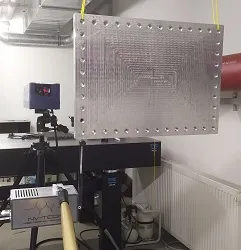

The exposure of human beings to vibration and noise can have implications ranging from annoyance to health damage. Hence, researchers of various fields, such as material scientists and control engineers, are concerned with the development of passive and active damping devices as well as the exploitation of material inherent damping. However, attempts to reduce the vibrational response of structures by additional mechanical damping can only be successful, if the extent of various damping phenomena occurring can be respectively quantified. Therefore, at our chair, we employ experimental as well as numerical methods in order to systematically study damping phenomena.
The chair's measuring equipment and software enable extensive testing in order to determine damping material and joint damping. In particular, the 3D laser scanning vibrometer allows measurements with a relatively high precision even on slightly damped structures, without affecting the structural response through the application of sensors. By performing a modal analysis and determining the 3dB-Bandwidth the modal damping values can be identified. The experimentally obtained damping values can be used to adjust numerical simulations subsequently.
An often-neglected contribution to the overall damping of structures is the dissipation of vibrational energy due to sound radiation. While acoustic radiation damping is rather small and negligible in many bulky engineering applications, it is the primary energy dissipating mechanism for lightweight structures with large radiating surfaces. We consider the fully coupled structural acoustic interaction, using FEM and BEM. The extent of acoustic radiation damping is quantified based on both harmonic response analyses and modal analyses.